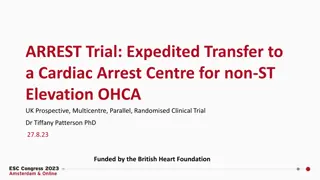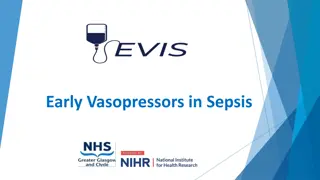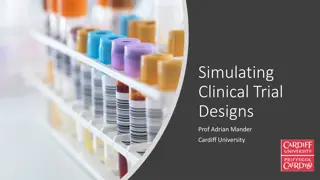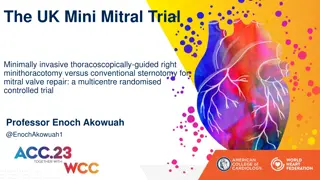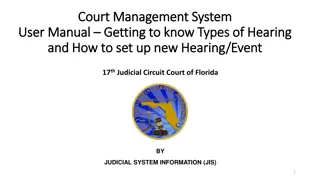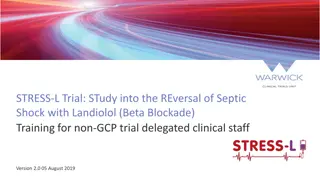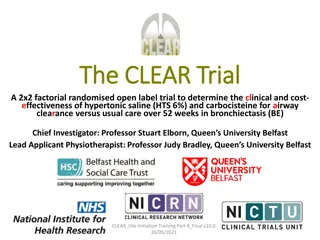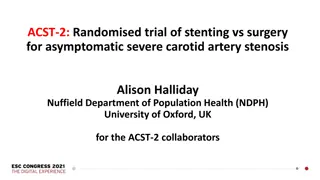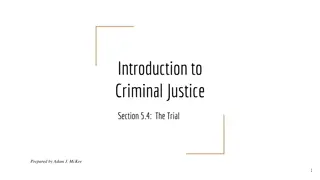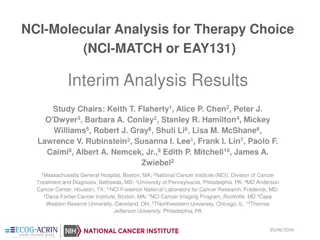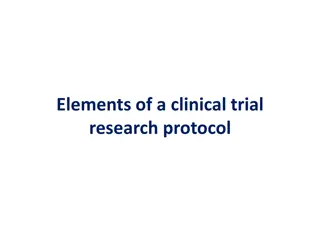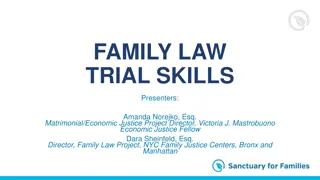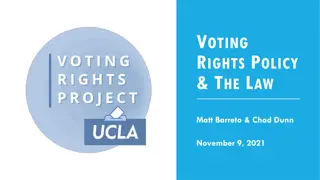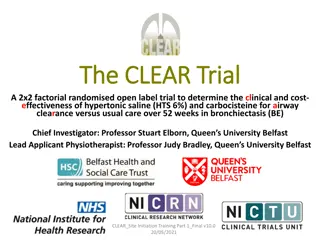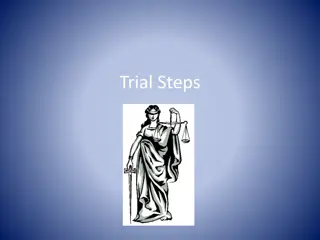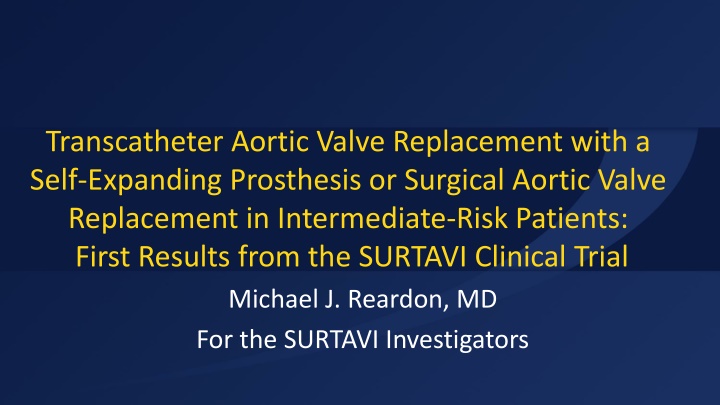
First Results from SURTAVI Clinical Trial: TAVR vs. Surgical AVR in Intermediate-Risk Patients
Study compares Transcatheter Aortic Valve Replacement (TAVR) with self-expanding prosthesis to Surgical Aortic Valve Replacement (SAVR) in intermediate-risk patients with aortic stenosis. Assessing safety and efficacy, the trial aims to evaluate endpoints like mortality, stroke, valve reintervention, and quality of life over 24 months.
Download Presentation

Please find below an Image/Link to download the presentation.
The content on the website is provided AS IS for your information and personal use only. It may not be sold, licensed, or shared on other websites without obtaining consent from the author. If you encounter any issues during the download, it is possible that the publisher has removed the file from their server.
You are allowed to download the files provided on this website for personal or commercial use, subject to the condition that they are used lawfully. All files are the property of their respective owners.
The content on the website is provided AS IS for your information and personal use only. It may not be sold, licensed, or shared on other websites without obtaining consent from the author.
E N D
Presentation Transcript
Transcatheter Aortic Valve Replacement with a Self-Expanding Prosthesis or Surgical Aortic Valve Replacement in Intermediate-Risk Patients: First Results from the SURTAVI Clinical Trial Michael J. Reardon, MD For the SURTAVI Investigators
Disclosure Statement of Financial Interest Within the past 12 months, I or my spouse/partner have had a financial interest/arrangement or affiliation with the organization(s) listed below. Financial Relationship Company Consultant (fees paid to institution) Medtronic 2
Background Self-expanding transcatheter aortic valve replacement (TAVR) is preferred to medical therapy in patients with severe, symptomatic aortic stenosis deemed prohibitive for surgical aortic valve replacement (SAVR)1, and is superior in patients at high risk for operative mortality at 30 days.2 The comparative efficacy of TAVR and SAVR has been less well studied in aortic stenosis patients at lower surgical risk. 1Popma J, Adams D, Reardon M, et al. J Am Coll Cardiol 2014 2Adams D, Popma J, Reardon M, et al. New Engl J Med 2014 3
Objective To assess the safety and efficacy of TAVR with the self-expanding valve vs. surgical AVR in patients with symptomatic, severe aortic stenosis at intermediate surgical risk 4
Trial Design Intermediate Surgical Risk Predicted risk of operative mortality 3% and <15% Heart Team Evaluation Assess inclusion/exclusion Risk classification Screening Committee Confirmed eligibility Randomization Stratified by need for revascularization Baseline neurological assessments TAVR SAVR TAVR only TAVR + PCI SAVR only SAVR + CABG 5
Study Endpoints Primary endpoint All-cause mortality or disabling stroke at 24 months Key secondary endpoints Safety: All-cause mortality All stroke Aortic valve reintervention Major vascular complications Life-threatening or major bleeding Pacemaker implantation Major adverse cardiovascular and cerebrovascular events (MACCE) Efficacy: Mean gradient EOA Moderate/severe AR Quality of life: KCCQ 6
Study Administration Principal Investigators: Patrick Serruys*, Nicolas Van Mieghem*, Michael Reardon*, Jeffrey Popma*, A. Pieter Kappetein*, David Adams, Stephan Windecker, R diger Lange, Thomas Walther Steering Committee Michael Reardon, Patrick Serruys, Nicolas Van Mieghem, Jeffrey Popma, A. Pieter Kappetein, David Adams, Blase Carabello, Eberhard Grube, R diger Lange, Nicolo Piazza, Thomas Walther, Stephan Windecker, Steven Yakubov, Mathew Williams, Lars S ndergaard, Thomas Gleason, G. Michael Deeb Echo Core Laboratory J. Oh, Mayo Clinic, Rochester, MN Data & Safety Monitoring Board D.P. Faxon, Prof. J.G.P. Tijssen, W.L. Holman, R.J. van Oostenbrugge, Cardialysis, Rotterdam, Netherlands Clinical Events Committee E. Jansen, H. Garcia-Garcia, W. Rutsch, C. Hanet, R. O. Roine, G. Amoroso, M. De Bonis, G. Andersen, J. Pomar, Cardialysis, Rotterdam, Netherlands Statistical Design and Analysis Andrew Mugglin, Paradigm Biostatistics, LLC Sponsor Medtronic * Executive Committee members 7
Participating Sites Canada and Europe Erasmus Medical Center Rotterdam, Netherlands 17 sites in Europe Amphia Hospital Breda, Netherlands Karolinska University Hospital Stockholm, Sweden Glenfield Hospital Leicester, UK Medisch Centrum Leeuwarden Leeuwarden, Netherlands Montreal Heart Institute Montreal, Quebec Rigshospitalet Copenhagen, Denmark Leeds General Infirmary Leeds, UK St. Antonius Ziekenhuis Nieuwegein, Netherlands German Heart Center Munich, Germany St. George s Hospital London, UK University Hospital Bonn, Germany Royal Sussex County Hospital Brighton, UK Toronto General Hospital Toronto, Ontario McGill Univ Health Center/Glen Hosp Montreal, Quebec Hospital Universitario Central de Asturias Oviedo, Spain Heart Centre - Bad Krozingen Bad Krozingen, Germany Universitatsspital Zurich Zurich, Switzerland London Health Sciences Center London, Ontario Sunnybrook Health Sciences Centre Toronto, Ontario Inselspital - Universitatsspital Bern Bern, Switzerland 5 sites in Canada Hospital Universitario Virgen de la Victoria Malaga, Spain 8
Participating Sites United States Beth Israel Boston, MA U of Michigan Ann Arbor, MI Detroit Medical Center Henry Ford Detroit, MI St. John Detroit, MI Fletcher Allen Burlington, VT Hartford Hartford, CT Spectrum Grand Rapids, MI Yale New Haven, CT Abbott NW Minneapolis, MN Winthrop Mineola, NY St. Francis Roslyn, NY Cooper U Camden, NJ Mayo Clinic Rochester, MN Stanford U Stanford, CA U of Rochester Rochester, NY UH Case Cleveland, OH Aurora St. Lukes Milwaukee, WI VA Palo Alto VA Palo Alto, CA North Shore Manhasset, NY Alegent Creighton Omaha, NE Riverside Methodist Columbus, OH Columbia Mount Sinai Lenox Hill NYU-Langone New York, NY Loyola Maywood, IL Pitt Ohio State Columbus, OH Iowa Heart Des Moines, IA Intermountain Murray, UT U of Kansas Kansas City, KS Pittsburg, PA El Camino Mountain View, CA St. Good Samaritan Cincinnati, OH Vincent Indianapolis, IN Morristown Morristown, NJ St. Luke s MAHI Kansas City, MO HUP Philadelphia,, PA Kaiser Permanente Los Angeles, CA Duke Durham, NC Wake Forest Winston Salem, NC Oklahoma Heart Kansas City, KS Geisinger Danville, PA Vanderbilt Nashville, TN USC Baptist Memorial Memphis, TN Los Angeles, CA Pinnacle Harrisburg, PA Carolinas Charlotte, NC Baylor Heart and Vascular Dallas, TX Emory University Atlanta, GA Banner Phoenix, AZ Cedars Sinai Los Angeles, CA Johns Hopkins Baltimore, MD Washington Hospital Center Washington, DC Piedmont Atlanta, GA Bon Secours Richmond, VA Scripps La Jolla, CA The Heart Hospital Baylor Plano Plano, TX Morton Plant Clearwater, FL Sentara Norfolk, VA Queens Medical Honolulu, HI CV Institute of the South Houma, LA Methodist Houston, TX 65 sites in the United States Delray Medical Center Delray Beach, FL U of Miami Miami, FL 9
Study Timeline 2012 2013 2014 2015 2016 April First patient enrolled June 19, 2012 Enrollment completed June 30, 2016 Evolut R (US) CoreValve: 23, 26 and 29 mm (US) Primary endpoint assessment Dec 2016 CoreValve: 23, 26 and 29 mm (CAN, EU) CoreValve: 31 mm (US, CAN, EU) 94% TF 4% DA 2% SCA Evolut R (n=139) CoreValve (n=724) 10
Key Inclusion Criteria Severe aortic valve stenosis defined by an initial aortic valve area of 1.0 cm or aortic valve area index <0.6 cm2/m2, AND a mean gradient >40 mmHg or Vmax >4 m/sec, at rest or with dobutamine provocation in patients with a LVEF <55%, or Doppler velocity index <0.25 by resting echocardiogram Heart team agreement that predicted 30-day surgical mortality risk is 3% and <15% based on STS PROM and overall clinical status including frailty, disability and comorbidity factors NYHA functional class II or greater 11
Key Exclusion Criteria Contraindication for placement of a bioprosthetic valve A known hypersensitivity or contraindication to all anticoagulation/ antiplatelet regimens Any PCI or peripheral intervention within 30 days of randomization Symptomatic carotid or vertebral artery disease or successful treatment of carotid stenosis within six weeks of randomization Recent cerebrovascular accident or transient ischemic attack Acute MI within 30 days Multivessel CAD with Syntax score >22 Severe liver, lung or renal disease Unsuitable anatomy including native aortic annulus <18 mm or >29 mm Severe mitral or tricuspid regurgitation Congenital bicuspid or unicuspid valve verified by echo 12
Definitions Stroke assessment All the patients were seen by a trained neurologist or stroke specialist at baseline. Follow-up neurological assessments were done at discharge, 30 days, 6, 12, 18 and 24 months. Neurologic events were adjudicated by a neurologist on the CEC. Stroke was defined according to the VARC-2 criteria. Disabling stroke was defined as a modified Rankin score of 2 at 90 days and an increase in at least 1 mRS category. Life-threatening or disabling bleeding was defined using BARC criteria. 13
Statistical Methods The SURTAVI trial utilized a novel Bayesian statistical methodology. The primary objective of the trial was to show that TAVR is noninferior to SAVR for all-cause mortality or disabling stroke at 24 months with a noninferiority margin of 0.07. The sample size of 1600 attempted implants assumed a 17% incidence of the primary endpoint in surgery patients. The primary and secondary endpoints were evaluated in the modified intention-to-treat (mITT) population. 14
Bayesian Analysis of the 24-Month Primary Endpoint Analysis Trigger A pre-specified interim analysis occurred when 1400 patients reached 12-month follow-up. Observed 24-month outcomes were used to inform modeling. Complete 12 month FU Final outcomes modeled <12 month FU Complete 24 month follow-up Information used to inform modeling Interim Bayesian Analysis of the 2Year Primary Endpoint timed to occur when 1400 subjects have been followed for 12 months Subjects who had not reached 24-month follow-up had their outcomes imputed using their last known event status. Combining imputed and observed data, the posterior distribution of the difference in 24-month event rates was calculated. N=1400 ~35% Number of Subjects ~50% Analysis using modeling to include all patient data ~15% 2012 2013 Attempted Procedure Date 2014 2015 2016 15
Standard of Success for Noninferiority of the Primary Endpoint Posterior Distribution of the Difference (TAVR rate SAVR rate) Standard of Success: PP( T - C< 0.07) > 0.971 (0.971 chosen to keep 0.05) Area > 0.971 -0.1 -0.05 0 0.05 0.1 PP = Posterior Probability; T = TAVR rate; C = SAVR rate 16
Patient Flow 1,746 patients randomized TAVR ITT group: N=879 SAVR ITT group: N=867 71 not attempted: - 4 died - 43 withdrew consent - 23 physician withdrew - 1 lost to follow-up 15 not attempted: - 4 died - 6 withdrew consent - 5 physician withdrew SAVR mITT* group: N=796 TAVR mITT* group: N=864 2 not implanted 1 went to SAVR 1 not implanted 2 went to TAVR 1 TAVR patient received SAVR 2 surgical patients received TAVR SAVR implanted group: N=794 TAVR implanted group: N=863 *The modified intention-to-treat (mITT) population includes all subjects with an attempted procedure 17
Baseline Characteristics* n (%) or mean SD TAVR (N=864) 79.9 6.2 SAVR (N=796) 79.7 6.1 Age, years Male sex 498 (57.6) 1.9 0.2 4.4 1.5 11.9 7.6 438 (55.0) 1.9 0.2 4.5 1.6 11.6 8.0 Body surface area, m2 STS PROM, % Logistic EuroSCORE, % 295 (34.1) 277 (34.8) Diabetes mellitus 14 (1.6) 17 (2.1) Serum creatinine >2 mg/dl 57 (6.6) 57 (7.2) Prior stroke 58 (6.7) 46 (5.8) Prior TIA 266 (30.8) 238 (29.9) Peripheral vascular disease 84 (9.7) 72 (9.0) Permanent pacemaker *mITT population; no significant difference in any baseline characteristics 18
Baseline Cardiac Risk Factors* n (%) TAVR (N=864) SAVR (N=796) Coronary artery disease 541 (62.6) 511 (64.2) Prior CABG 138 (16.0) 137 (17.2) Prior PCI 184 (21.3) 169 (21.2) Prior myocardial infarction 125 (14.5) 111 (13.9) Congestive heart failure 824 (95.4) 769 (96.6) History of arrhythmia 275 (31.8) 250 (31.4) Atrial fibrillation 243 (28.1) 211 (26.5) NYHA Class III/IV 520 (60.2) 463 (58.2) *mITT population; no significant difference in any baseline characteristics 19
Baseline Frailty, Disabilities and Comorbidities* n (%) or mean SD TAVR (N=864) SAVR (N=796) Body mass index <21 kg/m2 20 (2.3) 21 (2.6) Falls in past 6 months 102 (11.8) 101 (12.7) 5 meter gait speed >6 s 428 (51.8) 403 (52.9) 254.1 115.8 260.9 117.9 6 minute walk test (meters) Grip strength below threshold 519 (62.5) 490 (63.1) Does not live independently 18 (2.1) 22 (2.8) Chronic lung disease (mod/severe) 115 (13.3) 106 (13.3) Home oxygen 18 (2.1) 21 (2.6) Cirrhosis of the liver 4 (0.5) 5 (0.6) Immunosuppressive therapy 64 (7.4) 68 (8.5) *mITT population; no significant difference in any baseline characteristics 20
RESULTS 21
All-Cause Mortality or Disabling Stroke 30% All-Cause Mortality or Disabling Stroke 25% 24 Months TAVR 12.6% SAVR 14.0% 20% 15% 10% 5% 0% 0 6 12 18 24 Months Post-Procedure 555 612 No. at Risk SAVR 796 864 674 755 407 456 241 272 TAVR 22
Primary Endpoint Posterior Probability distribution Noninferiority margin PP >0.999 meets noninferiority -0.10 -0.05 0.00 0.05 0.10 Difference in 24-month incidence TAVR - SAVR TAVR (95% CI) SAVR (95% CI) Difference (95% CI) 12.6% (10.2%, 15.3%) 14.0% (11.4%, 17.0%) 1.4% ( 5.2%, 2.3%) 23
All-Cause Mortality 30% 25% TAVR SAVR All-Cause Mortality 20% 15% 30 Day SAVR 1.7% O:E 0.38 TAVR 2.2% O:E 0.50 10% 5% 0% 0 6 12 18 24 Months Post-Procedure No. at Risk SAVR 796 864 690 762 569 621 414 465 249 280 TAVR 24
All-Cause Mortality 30% 30% 24 Months 25% 25% 95% CI for Difference TAVR TAVR SAVR SAVR All-Cause Mortality 20% 20% 11.4% 11.6% -3.8, 3.3 15% 15% 30 Day SAVR 1.7% O:E 0.38 TAVR 2.2% O:E 0.50 10% 10% 5% 5% 0% 0% 0 0 6 6 12 12 18 18 24 24 Months Post-Procedure No. at Risk SAVR 796 864 690 762 569 621 414 465 249 280 TAVR 25
Instantaneous Hazard of Mortality 0.004 SURTAVI TAVR SURTAVI SAVR 0.0035 High-Risk TAVR High-Risk SAVR Estimated Hazard Rate 0.003 0.0025 0.002 0.0015 0.001 0.0005 0 0 30 60 90 120 150 Days Post Procedure 180 210 240 270 300 330 360 390 Guadiani V. Deeb GM, Popma JJ, et al. J Thorac Cardiovasc Surg 2017. 26
Disabling Stroke 10% 24 Months 8% 95% CI for Difference TAVR SAVR Disabling Stroke 2.6% 4.5% -4.0, 0.1 6% 4% 2% 0% 0 6 12 18 24 Months Post-Procedure No. at Risk SAVR 796 864 674 755 555 612 407 456 241 272 TAVR 27
Procedural Characteristics TAVR (n=864) SAVR (n=796) 95% CI for difference Characteristic, mean SD Procedure time, min 52.3 32.7 203.7 69.1 (-156.7, -146.1) Total time in cath lab or OR, min 190.8 61.3 295.5 81.6 (-111.7, -97.6) Aortic cross-clamp time, min NA 74.3 30.4 NA CPB time, min NA 97.8 39.3 NA Length of index procedure hospital stay, days 5.75 4.85 9.75 8.03 (-4.65, -3.36) (n=767) 48.6 44.0 (n=778) 70.4 96.2 Length of ICU stay, hours (-29.3, -14.3) 28
30-Day Safety and Procedure-related Complications TAVR (N=864) SAVR (N=796) 95% CI for Difference All-cause mortality or disabling stroke 2.8 3.9 -2.8, 0.7 All-cause mortality 2.2 1.7 -0.9, 1.8 Disabling stroke All stroke Overt life-threatening or major bleeding Transfusion of PRBCs* - n (%) 0 units 2 4 units 4 units Acute kidney injury, stage 2-3 1.2 3.4 12.2 2.5 5.6 9.3 -2.6, 0.1 -4.2, -0.2 -0.1, 5.9 756 (87.5) 48 (5.6) 31 (3.6) 1.7 469 (58.9) 136 (17.1) 101 (12.7) 4.4 24.4, 32.5 -14.5, -8.5 -11.7, -6.5 -4.4, -1.0 Major vascular complication 6.0 1.1 3.2, 6.7 Cardiac perforation 1.7 0.9 -0.2, 2.0 Cardiogenic shock 1.1 3.8 -4.2, -1.1 Permanent pacemaker implant Atrial fibrillation *Percentage rates, all others are Bayesian rates 25.9 12.9 6.6 43.4 15.9, 22.7 -34.7, -26.4 29
All-Cause Mortality by Pacemaker Implantation 50% PPI Prior to Procedure With New PPI Without New PPI P-value (log-rank) = 0.32 40% All-Cause Mortality 30% 20% 16.3% 10.5% 10.1% 10% 0% 0 6 12 18 24 No. at Risk PPI Prior Months Post-Procedure 87 74 59 46 28 217 198 164 121 56 With New PPI Without New PPI 559 491 400 300 197 30
Clinical Outcomes* at 12 and 24 Months 12 Months 24 Months 95% CI for Difference 95% CI for Difference TAVR SAVR TAVR SAVR All-cause mortality or disabling stroke 8.1 8.8 -3.5, 2.1 12.6 14.0 -5.2, 2.3 All-cause mortality 6.7 6.8 -2.7, 2.4 11.4 11.6 -3.8, 3.3 All stroke 5.4 6 .9 -3.9, 0.9 6.2 8.4 -5.0, 0.4 Disabling stroke 2.2 3.6 -3.1, 0.4 2.6 4.5 -4.0, 0.1 TIA 3.2 2.0 -0.4, 2.8 4.3 3.1 -0.9, 3.2 Myocardial infarction 2.0 1.6 -0.9, 1.8 2.8 2.2 -1.1, 2.4 Aortic valve re-intervention 2.1 0.5 0.4, 2.7 2.8 0.7 0.7, 3.5 Aortic valve hospitalization 8.5 7.6 -1.8, 3.6 13.2 9.7 0.1, 7.0 MACCE 13.2 12.8 -2.9, 3.7 18.6 18.6 -4.2, 4.2 *All are reported as Bayesian rates 31
Hemodynamics* TAVR had significantly better valve performance over SAVR at all follow-up visits AV Mean Gradient, mm Hg Aortic Valve Area, cm2 *Core lab adjudicated 32
NYHA Functional Class 0.2% 1.0% 0.3% 0.2% 100% 4% 4.4% 5% 5.0% 5% 6% 6% 10% 80% 33% 24% 26% 31% 36% 36% Percentage of Patients 54% 55% 60% NYHA IV NYHA III 40% NYHA II 63% 69% 58% 64% 53% NYHA I 71% 41% 20% 40% 0% 0.8% TAVR (N=860) SAVR (N=789) TAVR (N=822) SAVR (N=708) TAVR (N=607) SAVR (N=513) TAVR (N=302) SAVR (N=255) Baseline 30 Days 12 Months 24 Months 33
KCCQ Summary Score Over Time 100 Patients recover quality of life sooner after TAVR than SAVR KCCQ Summary Score 90 80 TAVR SAVR 70 60 50 40 Baseline 30 Days 6 Months 12 Months Change from Baseline TAVR 18.4 22.8 21.8 22.3 20.9 22.2 SAVR 5.9 27.0 21.3 22.3 20.6 22.2 95% CI for difference (10.0, 15.1) (-1.9, 2.8) (-2.2, 2.9) 34
Total Aortic Regurgitation* 1% 1% 1% 100% 3% 5% 5% 7% 9% 9% 90% 80% 36% 34% 35% 70% 60% Severe 50% Moderate 40% Mild 61% 90% 93% 30% 61% 90% 60% None/trace 20% 10% 0% TAVR (N=832) SAVR (N=707) TAVR (N=599) SAVR (N=506) TAVR (N=299) SAVR (N=244) Discharge 12 Months 24 Months * Implanted population, core lab adjudicated 35
All-Cause Mortality or Disabling Stroke at Subgroup 12 Months TAVR SAVR Hazard Ratios (95% CI) P for Interaction n/N (KM rate at 12 months) Age 0.82 <80 80 22/352 (6.6) 44/512 (9.2) 21/330 (6.8) 45/466 (10.0) 0.96 (0.53-1.74) 0.88 (0.58-1.33) Gender Male Female BMI 30 >30 LVEF 50 >50 PVD No Yes 0.73 42/498 (9.0) 24/366 (6.9) 38/438 (9.2) 28/358 (8.2) 0.94 (0.61-1.47) 0.83 (0.48-1.44) 0.56 44/527 (8.8) 22/337 (7.1) 41/486 (8.8) 25/310 (8.6) 0.98 (0.64-1.49) 0.79 (0.45-1.40) 0.73 10/131 (8.0) 56/732 (8.2) 12/133 (9.3) 52/657 (8.3) 0.81 (0.35-1.88) 0.95 (0.65-1.39) 0.67 42/598 (7.6) 24/266 (9.4) 45/558 (8.5) 21/238 (9.3) 0.86 (0.56-1.30) 1.00 (0.56-1.80) 2.00 1.00 0.50 0.125 0.25 Favors TAVR Favors SAVR 36
All-Cause Mortality or Disabling Stroke at 12 Months Subgroup TAVR SAVR n/N (KM rate at 12 months) Diabetes No 43/569 (8.0) 47/519 (9.5) Yes 23/295 (8.3) 19/277 (7.3) Revascularization Hazard Ratios (95% CI) P for Interaction 0.45 0.83 (0.55-1.25) 1.10 (0.60-2.02) 0.42 No Yes 47/695 (7.3) 19/169 (11.7) 50/633 (8.3) 16/163 (10.3) 0.84 (0.56-1.25) 1.15 (0.59-2.23) STS 0.06 <4 4 12/345 (3.8) 54/519 (10.8) 20/299 (7.2) 46/497 (9.5) 0.50 (0.25-1.03) 1.11 (0.75-1.65) Logistic EuroSCORE <10 10 5 m gait speed 6 sec >6 sec 0.84 31/429 (7.8) 35/435 (8.5) 35/432 (8.7) 31/363 (8.8) 0.87 (0.54-1.41) 0.93 (0.58-1.52) 0.78 29/399 (7.9) 33/428 (8.2) 30/359 (9.0) 32/403 (8.1) 0.86 (0.52-1.43) 0.95 (0.58-1.54) 2.00 1.00 0.50 0.125 0.25 Favors TAVR Favors SAVR 37
Summary SURTAVI met its primary endpoint demonstrating that TAVR with a self-expanding CoreValve or Evolut R bioprosthesis is noninferior to SAVR for all-cause mortality or disabling stroke at 24 months. 38
Summary TAVR had significantly less 30 day stroke, AKI, atrial fibrillation and transfusion use and a superior quality of life at 30 days. TAVR resulted in significantly improved AV hemodynamics with lower mean gradients and larger aortic valve areas than SAVR through 24 months. SAVR had less residual aortic regurgitation, major vascular complications and fewer new pacemakers. Need for a new pacemaker after TAVR was not associated with increased mortality. 39
Conclusion In SURTAVI, TAVR with the self-expanding valve was safe and effective treatment for patients with symptomatic severe AS at intermediate risk for surgical mortality IMPLICATIONS 40
Thank you to all of the SURTAVI patients, site personnel and investigators who made this trial possible

